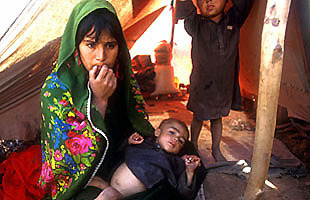World Refugee Day is an opportunity to pause and reflect on what are some of the most pressing and basic issues that refugees and displaced people face. There are an estimated 60 million refugees or internally displaced persons worldwide. Their circumstances vary greatly, from those temporarily displaced by conflict or natural disaster to those who spend years in camps or urban areas far from home. About two-thirds live in "situations of seemingly unending exile".(1)
While becoming a refugee changes many things, it does not change the human right to the highest attainable standard of health and well-being. All people regardless of race, ethnicity, sex, age and country of origin have health needs and specific vulnerabilities - and these are often exacerbated when they are forcibly displaced. For example, as refugees on the move, women and children may have problems accessing even basic services, such as care at the time of delivery, postnatal check-ups for mothers and babies, routine vaccinations and family planning. This leaves them exposed to common illnesses and often unable to plan their families.
Many people face life-threatening situations as a result of displacement. Of the 806 migrants estimated to have died or gone missing in the Aegean Sea en route to Greece in 2015, 33% were children - and most of these were under the age of 10. (2)
Risk to pregnant women
An estimated 26 million women and girls of reproductive age live in emergency situations. Humanitarian workers in Greece and the former Yugoslav Republic of Macedonia reported a high number of pregnant women among the refugees passing through in 2015, including some in the late stages of pregnancy. During one 12-hour shift, Red Cross staff at the exit point in Tabanovce recorded 16 pregnant women among the 128 people who used their services. (3)
Unfortunately, even when health services are available, the volatile circumstances of refugee status mean that many women and children are not willing or able to take full advantage. Observers near the borders in Greece and Macedonia gave examples of women leaving hospital less than 24 hours after giving birth to continue their journeys. Incredibly, some did so after Caesarean sections.
Threat of sexual violence
As of 2015, the average length of stay of a refugee outside his or her country of origin was 20 years, so many refugees will have spent much of their lives in camps or as urban refugees - alongside the host population, but often not enjoying the same rights and entitlements. About a third of the world's refugees live in camps. (4) According to UNFPA, standards vary widely - but often over-crowding, inadequate sanitation and lack of essential health care increase the risk of death and disease.
Women and girls are particularly vulnerable to sexual and gender-based violence in these settings, and those with physical or mental disabilities face heightened risk of abuse. A survey of adult rape survivors in the Bhutanese refugee camps in Nepal between 2009 and 2011 found that 49% had physical or developmental disabilities. (5) This quote from 16-year- old Ayan at the Minkaman Camp in South Sudan sums up the threat: "I feel unsafe when I go to the bush because there are often men who rape women."
Ensuring the right to health
So what can be done to empower women, children and adolescents - whether refugees or asylum-seekers - to access the health care and protection they need? First, the international community and receiving countries must face up to their responsibilities and obligations under international law, echoed in political commitments, including the Sustainable Development Goals (SDGs).
The Global Strategy for Women's, Children's and Adolescents' Health aims to ensure health and well-being for all women, children and adolescents "everywhere". In crises and conflict settings, it asserts the need to urgently address gaps in services, focusing on humanitarian and fragile settings and integrating emergency responses.
Second, all countries and humanitarian partners should deploy the Minimum Initial Service Package for reproductive health during emergencies. This package provides clinical care for survivors of rape, makes condoms available to prevent HIV transmission, and ensures availability of skilled birth attendants to prevent maternal and newborn mortality.
Third, countries need to develop strong and resilient health systems that are accessible to all populations within their jurisdiction, including refugees, asylum-seekers and other forcibly displaced populations. The World Health Organization has developed a toolkit to help countries assess the readiness of their health systems to cope, which it has piloted in countries across southern Europe. Greece, one of the main points of entry to Europe for refugees, applied to the European Commission in 2015 for emergency funding for a health response plan. (6) In June 2015, the Macedonian government gave refugees access to free health care from public health centres and hospitals.(7)
Gaps remain in our understanding of how the international community can better meet the needs of women and girls who are displaced from their homes. To inform this process, a World Health Organization report due in 2017, Women on the Move, will explore issues around women's health and mobility in the SDGs era. In an age when global mobility is increasing rapidly, how can we increase our knowledge of the health status and health needs of women and girls on the move?
As we mark World Refugee Day, let us live up to the commitment to ensure the right to health applies equally to every human being, whatever their circumstances. The SDGs commit countries to embark on a collective journey that leaves no one behind. No one. The message could not be more clear.
Find more information on heath and human rights as well as issues of health through the life-course at the World Health Organization.
Footnotes: 1-Milner and Loescher, 2011; 2-Fatal Journeys, Figure 6; 3-INITIAL ASSESSMENT REPORT: Protection Risks for Women and Girls in the European Refugee and Migrant Crisis Greece. UNHCR; 4-Shelter from the storm; 5-Shelter from the storm; 6- http://www.who.int/bulletin/volumes/93/12/15-021215/en/; 7- Shelter from the storm, page 13.

